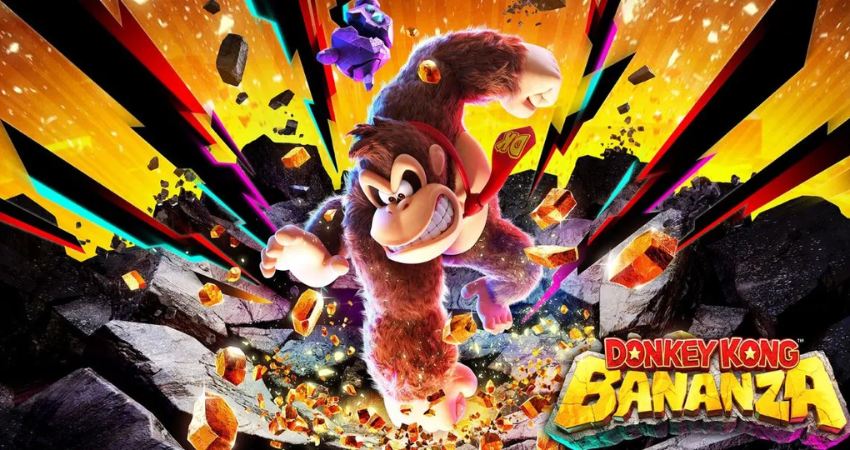Game Review: Donkey Kong Bananza
As I loaded up Donkey Kong Banaza – one of the two big flagship Nintendo Switch 2 launch titles, second only to Mario Kart World in importance – I wondered how Donkey Kong would fare as a protagonist. Donkey Kong’s history within Nintendo games is an interesting one – once a character synonymous with progress, one who was used to push arcade and console technology to new heights (see Donkey Kong Country, Donkey Kong 64, and the original arcade release), most recent Donkey Kong games have been throwbacks and re-releases. Bananza is from the team behind the superlative Super Mario Odyssey on the original Switch, and has carried a lot of expectations with it. Can an old monkey learn new tricks?
As it turns out, he can. Donkey Kong Bananza is one of the most exciting and creative Nintendo-published titles in some time, one that takes a good central idea – what if Donkey Kong can smash his way through most of the level’s architecture – and leans into it heavily. This is a chaotic, ridiculous game where you’re almost always seconds away from smashing something, hurling a huge rock at an enemy, or finding some other way to do massive damage – and it’s so, so fun. You can feel the game bucking under the weight of its own ambition – the frame rate occasionally slows down for a second, and the camera struggles to keep up – but it’s a small price to pay.
Bananza is kind of, sort of, a prequel to the original Donkey Kong, first released in 1981. It takes Pauline, the damsel that Kong has apparently kidnapped in that first game, and reinvents her as a spunky teenager, one who’s always by your side, using her singing abilities to aid DK in various ways. Pauline bucks all the trends you might expect from that description – far from an annoying sidekick, she’s a charming, fun character, one who ends up being integral to the game’s surprisingly interesting plot. DK himself has received a full makeover, and his new design is incredibly charming, too – it’s a huge improvement, and an unusual move from Nintendo.
Three of the four face buttons on the controller are punch buttons in Banaza. You can punch up, down, or immediately in front of you, and the levels are designed in such a way that you can punch your way through most problems. Essentially, every level has a sort-of indestructible skeleton – dig deep enough and you’ll hit a layer of hard metal – but you can rip apart everything around it, tearing off chunks of ground to throw at enemies and digging holes right through levels.
In games that afford you this level of destructibility, often the challenge that developers face is in how to restrict the players in meaningful ways, limiting their opportunities to wreck things so that they don’t just smash their way through entire levels. Bananza, to its credit, does not do this, which feels more and more daring the deeper you go. Breaking your way through the environment can unveil treasures (which can be spent on a variety of upgrades), bananas (the main collectable, used to level Donkey Kong’s abilities up) and fun hidden challenge areas. If you want to, you can play this game in a very straightforward way, following objectives through to their end and skipping over most of the collectables. But part of the fun is allowing yourself to be lured off course, digging through levels to find everything hidden. There is, in fact, a huge amount to discover – only truly dedicated players will nab all 777 bananas.
Nintendo’s 3D platformers usually feature great boss fights, and Bananza is no exception. Boss encounters will make use of your full arsenal of attacks (including DK’s ability to transform into other animals and use their unique abilities), and these fights are usually fast, frantic affairs. DK’s energetic, destructive combat style also makes dealing with regular enemies extremely enjoyable, moreso than is typical for this genre. Ripping a chunk of the ground up and throwing it at a distant enemy is satisfying – surfing along the ground on that chunk before jumping off and smashing it over a bad guy’s head is even better. You really feel the impact of your every action.
This game just keeps on giving, with every new level revealing fun new mechanics and ideas, and every new horizon presenting fresh opportunities to break things. Even the simple co-op mode is great – one player controls a reticule on screen and can make Pauline absorb different materials and then “shout” them out. It’s great to have another player handle enemies while you run and jump through a level, and it’s the sort of mode well-suited for young kids or folks with less experience with the genre.

Donkey Kong Bananza has that certain something – that Nintendo magic, if you will – that you find in their best first-party releases. There’s an energy and ambition here that talks to the experience of the team, and the whole game is engineered around the player experiencing joy. Donkey Kong has, once again, been reinvented, and he’s better than ever. Donkey Kong Bananza is available now on Nintendo Switch 2. A review copy was provided by Nintendo Australia.
James O’Connor has been writing about games since 2008. He is the author of Untitled Goose Game for Boss Fight Books.






